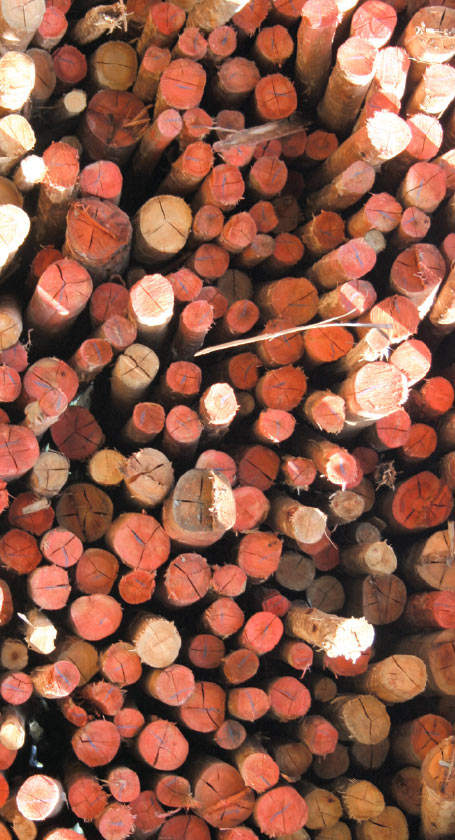 Wood from Eucalyptus grandis
Wood from Eucalyptus grandis
Although traditional uses of wood, such as timber for furniture and especially pulp and paper, make up an important part of the South African economy and job market, new avenues for the use of woody biomass are resulting in significant investment internationally. In addition to value from forestry, much of the research on how wood forms can be applied to other biomass-producing crops, including waste products from food crops such as maize or sugarcane.
The synthesis of wood involves a series of developmental processes that are meticulously coordinated in the genome of the particular tree. Within each of millions of individual living fibre cells, several thousand proteins and small molecules import the necessary carbon in the form of sugars and convert it into polysaccharides such as cellulose and hemicellulose, while some sugars are converted to aromatic molecules which polymerise to form lignin.
Dr Eshchar Mizrachi’s group models the formation of wood, from the determination of cell identities to their development, to the allocation and processing of carbon and other small molecules inside to form these valuable biopolymers in the secondary cell walls. This is achieved by measuring and analysing different ‘layers’ of biology (that is, how genes are expressed, how proteins are synthesised, and how small molecules like sugars and phenolics are made). The integration of this knowledge across various tissues or states of wood formation is called systems biology – a holistic approach that provides a top-level view of the organisation of these small molecules during wood development. Since the variation in the genome of trees contributes to how genes are expressed, an exciting dimension to this research is modelling this process across related individuals in a population, referred to as systems genetics. Here, the integration of data for thousands of genes, hundreds of metabolites, and dozens of industrially important traits across several hundred trees, has led to the reconstruction of a model that shows which parts of the system have an impact on carbon availability, growth, density, and the formation of important biopolymers.
With this new insight and a rich model, the group focuses on two important aspects. Firstly, how is carbon used during wood formation and allocated to form the different biopolymers, particularly in the metabolically active organelles (compartments within the cells) such as plastids and mitochondria? Secondly, since this process is common to most land plants, how has it evolved? Which programmes are common and which genes may contribute to differences in cell wall chemistry observed in, for example, Eucalyptus trees, poplar trees, corn stems, sugarcane or even ferns? Testing these genes using synthetic biology can lead to new biotechnology strategies for the use of biomass.
In addition to his research in the Department of Genetics and FABI, Dr Mizrachi was one of the first fellows of the Africa Science Leadership Programme (ASLP), a Global Young Academy, University of Pretoria and Future Africa initiative that brings together scientists from Africa with the aim of developing research excellence, visibility and interdisciplinarity in Africa. Following his training in the ASLP in 2015, he co-organised and was a mentor in the first Tuks Young Research Leader Programme (TYRLP) in the same year, led by Professor Bernard Slippers. Through ASLP he is part of a working group with other scientists from Uganda, Mauritius, Ghana and Kenya, focusing on improving uptake of online educational resources in Africa, and methods to disseminate these resources offline for areas with poor internet access. (See pages 12 and 13.)
 Dr Eshchar Mizrachi (middle) and his research team (from left): Desre Pinard (PhD student), Riaan Swanepoel (MSc student), Daniel Harty (BSc honours), Mark Maistry (Postdoctoral fellow), Jonathan Botha, Drew Behrens, and Elodie Ekoka (PhD student). Danielle Roodt (PhD student), is not in the photograph.
Dr Eshchar Mizrachi (middle) and his research team (from left): Desre Pinard (PhD student), Riaan Swanepoel (MSc student), Daniel Harty (BSc honours), Mark Maistry (Postdoctoral fellow), Jonathan Botha, Drew Behrens, and Elodie Ekoka (PhD student). Danielle Roodt (PhD student), is not in the photograph.